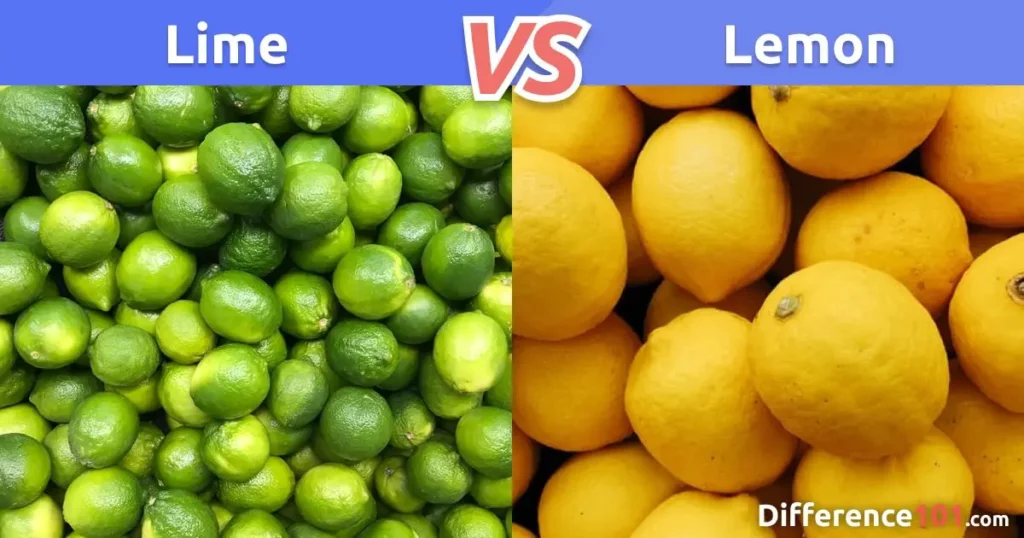Introduction
Lemons and limes are both citrus fruits known for their tangy flavor and versatility in cooking, baking, and beverages. While they may appear similar at first glance, there are several key differences between the two fruits in terms of taste, appearance, and culinary uses. In this comprehensive guide, we’ll explore the distinct characteristics of lemons and limes and discuss how they differ in various aspects.
Flavor Profile
Lemons
Lemons are known for their bright, acidic flavor with a hint of sweetness.
They have a tartness that adds zest to both sweet and savory dishes.
Lemon juice is commonly used in beverages, salad dressings, marinades, and desserts.
Limes
Limes have a tangy, slightly bitter flavor with less sweetness compared to lemons.
They are often used in dishes where a sharper, more pronounced acidity is desired.
Lime juice is popular in cocktails, salsas, marinades, and Southeast Asian cuisine.
Appearance
Lemons
Lemons are typically larger than limes and have a bright yellow color when ripe.
They have a smooth, glossy skin with a slightly rough texture.
Limes
Limes are smaller than lemons and have a vibrant green color when ripe.
They have a thinner skin with a smoother texture compared to lemons.
Culinary Uses
Lemons
Lemons are versatile and can be used in a wide range of dishes, both sweet and savory.
Lemon zest and juice are commonly used to add flavor to salads, seafood, poultry, and baked goods.
Lemon slices or wedges are often used as a garnish for drinks and dishes.
Limes
Limes are popular in cuisines around the world, particularly in Latin American, Southeast Asian, and Indian cooking.
Lime juice is a key ingredient in dishes such as guacamole, ceviche, pad thai, and curry.
Lime zest adds brightness and aroma to desserts, cocktails, and savory dishes.
Nutritional Content
Lemons
Lemons are a good source of vitamin C, providing about 31 mg per 100 grams.
They also contain small amounts of other vitamins and minerals, including potassium and vitamin B
Limes
Limes are also rich in vitamin C, with approximately 29 mg per 100 grams.
They contain similar nutrients to lemons, including potassium and vitamin B
Health Benefits
Lemons
Lemons are known for their antioxidant properties, which may help protect against chronic diseases such as heart disease and cancer.
They contain compounds like flavonoids and limonoids, which have been studied for their potential health benefits.
Limes
Limes also contain antioxidants that may contribute to overall health and well-being.
The flavonoids found in limes have been associated with reduced inflammation and improved heart health.
Culinary Tips
When choosing lemons and limes, select fruits that are firm, heavy for their size, and free of blemishes or soft spots.
To extract the most juice from lemons and limes, roll them on a hard surface before cutting and juicing.
Store lemons and limes in the refrigerator to prolong their freshness, but bring them to room temperature before using to maximize juice yield.
FAQs
Can I substitute lemons for limes in recipes and vice versa?
Yes, lemons and limes can often be used interchangeably in recipes, although there may be subtle differences in flavor. For example, if a recipe calls for lemon juice and you only have limes on hand, you can usually use lime juice as a substitute and vice versa.
Are there any health risks associated with consuming lemons and limes?
Generally, lemons and limes are safe to consume in moderation as part of a balanced diet. However, some individuals may experience digestive discomfort or allergic reactions to citrus fruits. If you have a citrus allergy or sensitivity, it’s best to avoid lemons and limes.
Can I freeze lemons and limes for later use?
Yes, you can freeze lemons and limes to extend their shelf life. Simply wash and dry the fruits, then place them in a freezer bag or container and store them in the freezer. Frozen lemons and limes can be grated or juiced directly from frozen for use in recipes.
Are there any culinary uses for lemon and lime zest?
Yes, lemon and lime zest can add bright, citrusy flavor to a wide range of dishes, including salads, marinades, desserts, and cocktails. Use a microplane or zester to grate the outer peel of the fruit, being careful to avoid the bitter white pith.
Can I use bottled lemon and lime juice instead of fresh?
While fresh lemon and lime juice is preferred for its flavor and acidity, bottled juice can be used as a convenient alternative, especially when fresh citrus is not available. Just be sure to check the ingredient list for any additives or preservatives.
What are some creative ways to use lemons and limes in cooking?
In addition to traditional uses in salads, marinades, and beverages, lemons and limes can be used in a variety of creative ways in cooking. Try using lemon or lime zest to flavor rice, couscous, or quinoa, or add a squeeze of citrus juice to soups, stews, and sauces for a burst of freshness.
Conclusion
Lemons and limes are both versatile citrus fruits that add brightness and acidity to a wide range of dishes. While they share some similarities in flavor and appearance, they also have distinct characteristics that make them unique. Whether used in cooking, baking, or beverages, lemons and limes are essential ingredients that can elevate the flavor of any dish.

